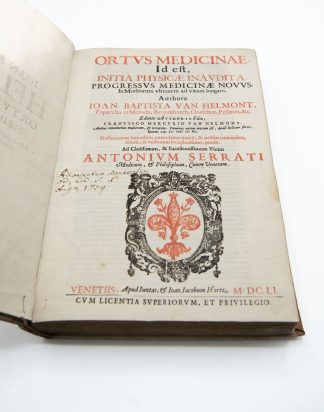HELMONT, Jan Baptist, van.
‘ONE OF THE FOUNDERS OF BIOCHEMISTRY’
Ortus medicinae.
Venice, apud Iuntas et Ioan. Iacobum Hertz, 1651.£2,750.00
Folio. 2 parts in 1, separate title to each, pp. [34], 700. Roman letter, with Italic, double column. General title with woodcut printer’s device in red and black, 3 small woodcut medical instruments, decorated initials and ornaments. Tiny worm trail at blank foot of first gathering, very light age browning, very slight water stain towards head on second half, long clean tear at lower edge to Bb2 repaired. A very good copy in contemporary Dutch vellum over boards, early ms title to spine, c1700 ms Latin note on Van Helmont to ffep verso, ms ‘Ad Conventum Monacensem Ord[inis] Ere[mitarum] S. Aug[usti]ni 1734’ to title.
Jan Baptist van Helmont’s complete works, edited posthumously by his son, with revisions not present in previous editions (cf. Rommelaere, p.63). In this work, Helmont established his name as one of the founders of biochemistry, although some authorities believe that he is perhaps overrated because of his vacillations between mysticism and science. […] his discovery of digestive juices in the stomach and intestine, and especially his first use of the specific gravity of urine for diagnostic purposes, mark him as a man of no insignificant importance in the history of medicine’ (Heirs of Hippocrates n.409).
Van Helmont (1580-1644) was a chemist and physician from Brussels, trained at Leuven. Influenced by Paracelsus and iatrochemical theories – i.e., the interpretation and study of medicine and physiology in chemical terms – he partly repudiated them due to his study of mysticism and the ‘New Learning’, based on experimentation, upheld by Harvey and Bacon. Part I begins with the author’s biography and core ideas, including his dislike of astrology, his scientific views and understanding of physiology, physics and natural science in relation to the ‘errors’ of Aristotle, Llull, Galen and Paracelsus. Here are his theories of ‘ferment’ – very near to today’s ‘enzyme’ – a chemical substance found in the stomach and aiding digestion, as well as his theory of ‘gas’ – the first recorded appearance of the word in the modern sense – as an invisible substance different from atmospheric air. The remainder discuss dozens of topics spanning mental impairment (‘amentia’ and ‘dementia’), the seat of the soul, blood circulation (inspired by Harvey), digestion, asthma, cough, ulcers, catarrh, pharmacopoeia and dropsy. Most interesting is the account of his meeting with the Irish alchemist William Butler, who owned a ‘lapillus’, a small stone (thought to be by some the philosopher’s stone), which could treat conditions such as severe poisoning. There follows ‘Tractatus de morbis’, devoted to internal pathology and remedies, beginning with the nature of illnesses and continuing with, among others, the virtues of gems, stones and herbs; death, the best nutrition for infants and the magnetic treatment of wounds. Part II comprises his ‘Opuscula Medica Inaudita’, in four parts – on kidney stones, fevers, Galen’s humours and the plague – which discuss physiology, diagnostics, symptomatology, treatment and prognosis. ‘Tumulus pestis’, inspired by the Amsterdam plague of 1605, was reviewed by Newton in 1667.
Krivatsy 5431; Ferguson, Bib. Chemica, I, 381; Heirs of Hippocrates (1648 ed.); Wellcome (1648 ed.); Osler (1648 ed.). W. Rommelaere, Études sur J.B. Van Helmont (1868).In stock




